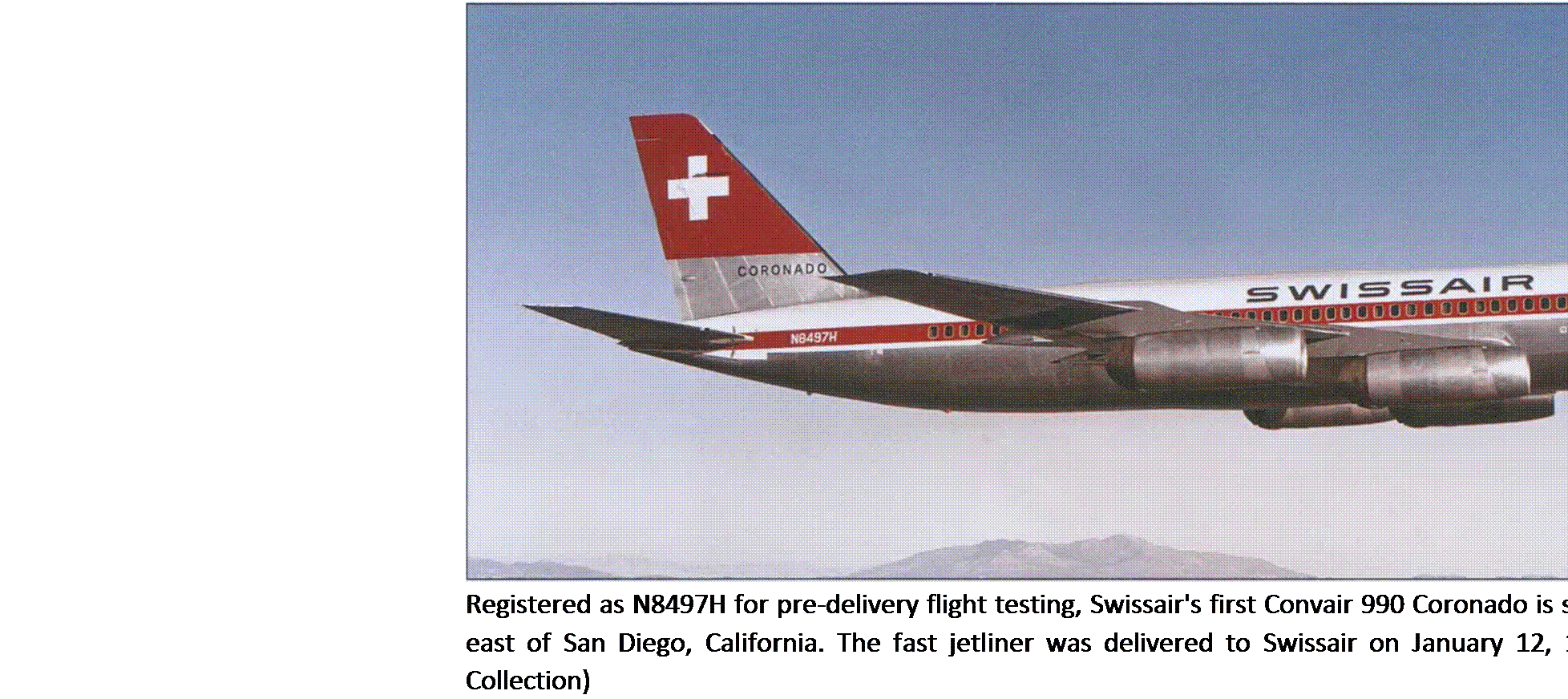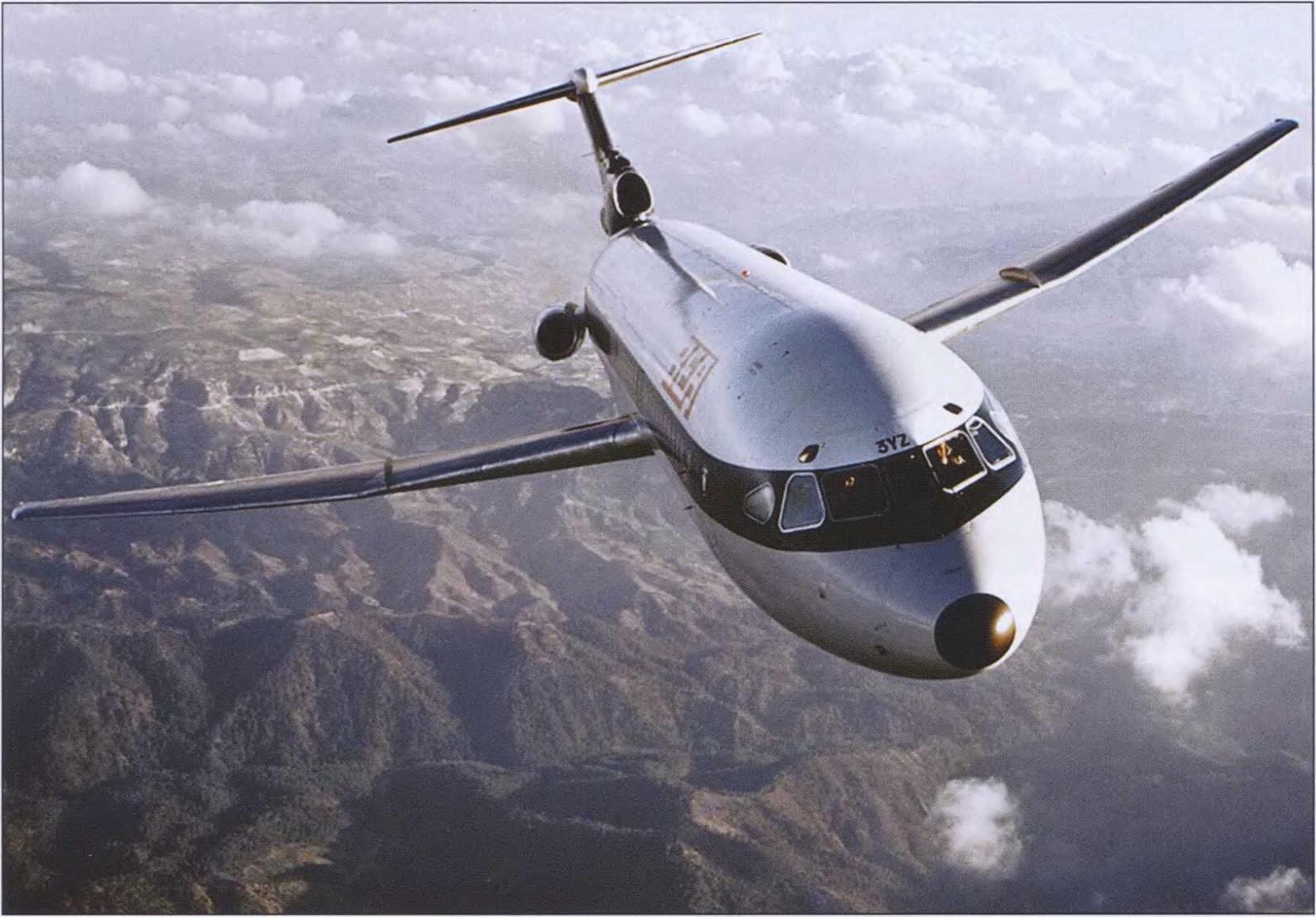Convair 990
American Airlines’ Chairman C. R. Smith saw the advantage of turbofan power early on, from both an economic and a competitive point of view. In August 1958, he ordered 25 Convair Model 30 jetliners from General Dynamics for $100 million. Commercially marketed as the 600 and later renamed the 990, this follow-on version of the 880 was to be 139 feet 6 inches long with a maximum takeoff weight of 240,000 pounds and powered by General Electric CJ-805-21 “ducted fan” engines to give it a speed advantage over the Boeing and Douglas jetliners already on order. With Pratt & Whitney’s turbofan engine development running 18 months behind General Electric, the new Convair jet was only offered with GE powerplants.
A distinctive design feature unique to the 990 was the appearance of four anti-shock bodies mounted on the upper trailing edge of its ultra-thin wing. Resembling large inverted canoes, these pods utilized the same new “area rule” aerodynamic technology that greatly enhanced the performance of supersonic military jets. For the 990, this served to optimize the aircraft’s lift/drag ratio at speeds above Mach.80. Additionally, these “speed pods” served as supplemental fuel tanks located optimally close to the airplane’s center of gravity.
Convair engineers did a masterful job of evoking the look of speed in their new jetliner. Swept back 39 degrees at the leading edge, the 990’s wing planform

bespoke superior Jet Age performance, which became a major selling point of the airplane. With the ability to offer 635-mph Blue Streak coast-to-coast nonstop flights 45 minutes faster than the competition, American’s managers planned to configure the 990 in an all-first-class layout, with 707s to carry coach passengers on the plebian “slower” flights.
General Electric upgraded the existing CJ-805 design that powered the Convair 880 by adding a fan and turbine on the engine’s rear end, saving development time and allowing a higher bypass ratio. By pulling additional air around the basic engine and exhausting it at low velocity through a double-jet nozzle, the production GE CJ-805-23 improved operating efficiency by up to 40 percent over the non-fan model, creating 16,100 pounds of thrust.
Convair executives went ahead with the 990 based solely on American’s order, which included a guaranteed 635-mph speed and the ability to operate between New York’s LaGuardia and Chicago Midway Airports. It was a particularly bold move, especially considering the attractive purchase contract that included an inflated $22.8 million credit on the trade-in of 25 DC-7s instead of a down payment. Although launch customers normally receive generous discounts, this contract would require a long 990 production run to spread out the costs.
Additional customers proved to be elusive and Convair lost significant orders from Pan Am, Continental, and other customers. In fact, American was the only U. S. buyer, along with a handful of airplanes purchased by Swissair, Varig, and Garuda. Failure to build a prototype aircraft took a heavy toll on General Dynamics when wind tunnel tests failed to disclose significant design problems. Fixing them nearly
resulted in an order cancellation from American Airlines. It was saved by long wait times at Boeing and Douglas and American’s need for more jet equipment. Convair granted even deeper discounts on the order and accepted cancellation of five airplanes.
In the end, the modified 990, designated the 990A, could not match its original guarantees and the type entered service with American on March 18, 1962, between New York and Chicago, but using Idlewild and O’Hare Airports; the LaGuardia and Midway plans had been long-since canceled by the type’s redesign. Instead of a single, premium-class cabin, 57 coach seats were installed, along with 42 in first class plus a four-place lounge. American’s only 990 transcontinental flights operated briefly from San Francisco to New York. Unable to complete the segment against prevailing winds, the 990 flew only the eastbound segment.
Swissair ordered the airplane’s overseas version named Coronado, which beat American’s 990s into regular service by nine days, and kept its fleet in operation for 12 years. Except for a three-year stint with Middle East Airlines, second-hand 990 fleets served mostly charter outfits and travel clubs for several years but were eventually taken out of service when stiffer noise rules went into effect.
Only 37 990s were built, resulting in massive financial losses. Combined with the 880 shortfall, General Dynamics wrote off $425 million on the program, by far the largest loss of any corporation at the time.
de Havilland/Hawker Siddeley H. S. 121 Trident I
Although not technically a “fanjet,” the Trident still deserves mention. Having first flown in January 1962, this novel airliner provides us with a peek into the
 British European Airways became the first operator for the Hawker Siddeley Trident with a 24-airplane order. The advanced trijet first flew on January 9, 1962. (BAE Systems)
British European Airways became the first operator for the Hawker Siddeley Trident with a 24-airplane order. The advanced trijet first flew on January 9, 1962. (BAE Systems)
future. It was a smaller airplane than the popular four – engine intercontinental jetliners of the time, and was quite a technologically advanced aircraft as well. Although the Trident may not have been a success when compared to other first-generation jetliners that preceded it, this airplane indeed served as a harbinger of things to come.
The Trident story is fraught with frustration, for had the original 1958 design concept been frozen and heralded into production, such legendary airliners as the Boeing 727 might never have reached production. How can we make such a bold assumption? Simply stated, this aircraft was originally to be a short – to medium-range airliner powered by three Rolls-Royce RB.141 Medway “by-pass” turbojets producing 14,000 pounds of thrust each. The original Trident would have weighed between 130,000 and 150,000 pounds at takeoff and carried 110 passengers over routes of up to
1,500 miles in length. (These were the approximate specifications of the Boeing 727, only five years before that aircraft entered service!)
As happens in modern industrialized societies, an insidious combination of politics and corporate wrangling can combine to put a stranglehold on progress, and the Trident succumbed to just this type of industrial “perfect storm.” Originating manufacturer de Havilland was caught in the maelstrom of British aerospace consolidation, orchestrating a merger with Fairey and Hunting to form a new company called Airco. Combined with this series of events was the
insistence of launch customer BEA on having the new tri-jet be reduced in size, weight, and capacity to become a 107,000-pound, 80-passenger jetliner. BEA then ordered 24.
This pivotal change was enacted to make the airplane more suitable for the specific needs of BEA at the expense of overall world market appeal, and Britain’s airliner industry never recovered from this stumble. Many months of critical timing and market advantage were squandered as design changes were contemplated and then adapted. The Airco merger became moot when de Havilland became a component of the Hawker Siddeley Group. Now powered by three 10,400-pound – thrust Rolls-Royce RB.163 Spey by-pass turbojets, the smaller Trident I finally flew for the first time on January 9, 1962, and slowly reached production and operational status by the end of 1963.
As the worlds first airliner to be certified for “zero-zero” autoland operations (precursor to today’s full Category III landing capability), the Trident distinguished itself as an airplane that represented the future of commercial aviation. Although larger stretched models were subsequently produced and were ultimately successful within the small market niche, the Trident was quickly relegated to the back pages of airliner prominence. As with many other British transports, the diminutive tri-jet from Hatfield was soon outdone by stronger competitors from the United States, which once again emerged victorious in world markets.










